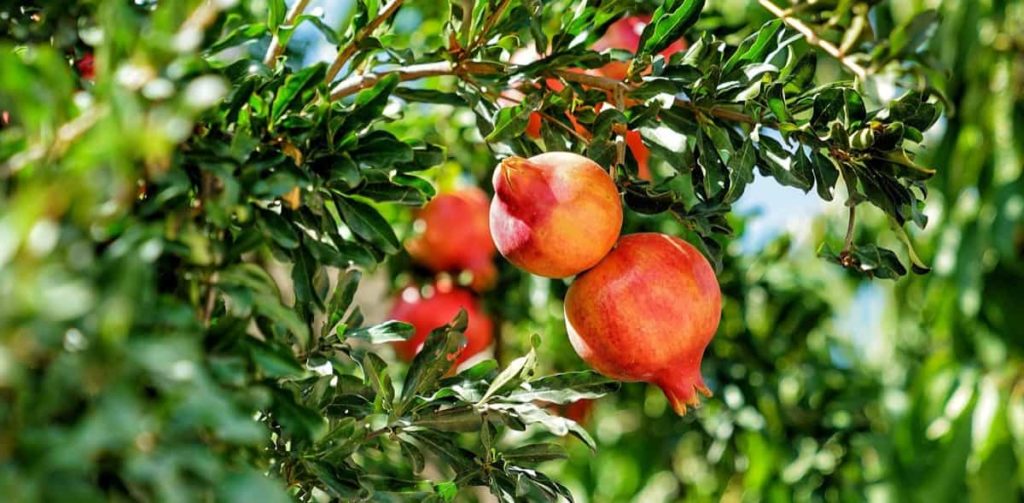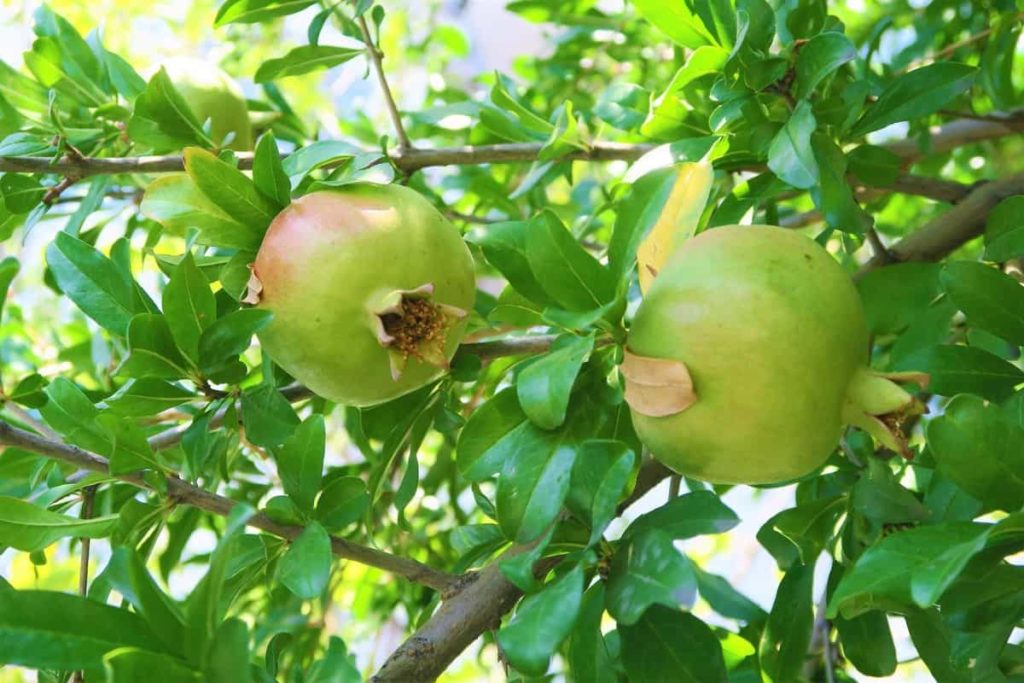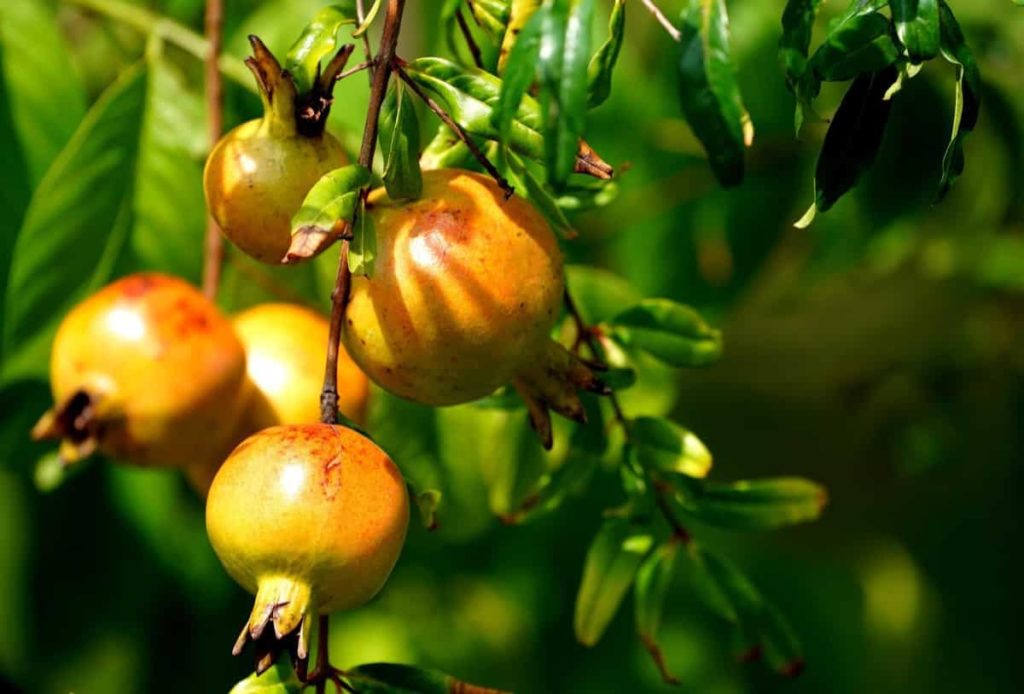Pomegranate shows minimal requirements for the type of soil suitable for its cultivation. It can be cultivated with satisfactory results from sandy to rocky and gravel soil and from relatively shallow to deep, including all the middle soil types. Considering the need for soil, it can be grown under different soil varieties, from low fertility to high fertility soil. However, it gives an excellent yield. Let’s check out how to prepare the soil for Pomegranate Plants/Trees.

Pomegranate adapts to almost all soil types, regardless of composition or structure, unless it is full of water. To make Pomegranate trees productive for each different soil type, a proper cultivation process has to be followed. For example, plants in light sandy soil should be supported by irrigation and enhanced fertilization.
However, the soil most conducive to establishing a commercial Pomegranate plantation is rich in organic matter alluvial sandy loam, which has the best nutritional potential and drainage while maintaining the necessary moisture. In India, they are known to grow in rocky gravel. The only soil that will not support Pomegranate is heavy, as excessive soil presents drainage problems.
How to prepare the soil for Pomegranate Plants/Trees
Soil pH for Pomegranate
A slightly acidic soil from neutral is perfect for Pomegranate. Of course, they will still survive in significantly more acidic or alkaline conditions, but the 5.5 to 7.0 pH range is excellent. If necessary, you can raise your soil pH by adding ground agricultural limestone or reduce it by adding sulfur. The soil test kit available at most garden stores will tell you pH and your soil nutrients. Pomegranates are quite favourable according to different degrees of soil acidity or alkalinity.
Although they prefer light acid soil, they can grow well in other types. Their basic needs are immediate drainage, plenty of sunlight, and a long, hot growing season. During fruit growth, a hot and dry climate improves the quality of fruits. Heavy soil with poor drainage facilities is not suitable for Pomegranate cultivation. Pomegranates are adapted well enough to grow in poor soil, but moderate nutritional levels are better for fruit production. You can compost your trees with a small application of some kind of nitrogen fertilizer during their first two springs.
Preparation of soil for growing Pomegranate in pots
The difference between Pomegranate and many other fruit trees is the wide range of soil in which Pomegranate grows. Pomegranate will grow from heavy, black loam, lime-rich, and dry, rocky hillsides to sandy soils. Although most of the average soil of Pomegranates will tolerate any kind, they grow best in fertile, deep, loam soil rich in humus, mostly from other fruit trees.
In case you missed it: Best Fertilizer for Pomegranate Tree: Homemade, Natural, Organic, and Compost Manure

Pick the well-draining growing medium and add enough organic matter for the best fruits. You will need to mix two parts of sand, one part of potting soil, and one part of peat moss until you fill your container. This soil is perfectly creating a well-drained soil system for Pomegranates. Since a potted plant eventually eliminates a limited amount of soil nutrients in its pot, it is important to fill these nutrients with extra fertilizer sooner or later.
Pomegranate requires potassium fertilizer every two weeks, from early summer to early fall will help the plant form and maintain its fruits. Or the same application of slow-release fertilizer in spring should remain during the growing season.
Preparation of soil for growing Pomegranate on grounds
Pomegranate does not have many soil requirements. Adding compost or well rotten manure to the soil is also a good idea to improve soil structure and beneficial plant elements. Besides soil type and drainage, site selection should also consider sun exposure and wind circulation. Pomegranate requires at least six hours of direct sunlight a day to ensure the color and productivity of good fruits. Aligning the garden rows north-south will maximize the exposure to the sun. However, soil drainage is more important than the orientation of rows.
How to grow Pomegranate in poor soil
Pomegranate needs well-drained soil, although it can thrive in various soils, from acid loams (preferred) to poor quality alkaline varieties. If you have clay-based soil or any other type of poor drainage, replace it with looser topsoil. Like most fruit trees, Pomegranate needs deep and well-draining soil. They will not tolerate water-filled soil, resulting in root rot. Avoid planting in heavy soil unless the soil has been modified.
In case you missed it: Pomegranate Growing Tips, Ideas, Techniques, Secrets
You can improve heavy soil by adding gypsum and organic matter and mounding the soil before planting to improve drainage. You should test soil for nutrients and purity to help determine how much water and fertilizer to give. One of the benefits of Pomegranate trees is their ability to grow in various soils, but they enjoy a fertile, rich loam with a lot of humus. It provides good drainage and maintains substantial moisture and accessible minerals.
The addition of well rotten manure or horse manure can improve poor soil to high organic matter levels. If the soil is heavy and adds organic matter, think about the tree’s position, avoid planting it where the water will accumulate and instead choose a place that will naturally drain more freely, such as over the slope.
Soil composting for Pomegranate
Chicken manure is the best choice of compost material for Pomegranates. Raw chicken manure contains ammonia that provides additional nitrogen to Pomegranates. Additional nitrogen will focus on vegetative growth rather than making Pomegranate delicious. On the other hand, when mixed with compost, excess ammonia evaporates and provides the right amount of nitrogen. Leaves are the best carbon sources, but you can also use a straw, sawdust, wooden chips, or even chopped paper.
Save your coffee ground and other kitchen waste with grass clippings and manure for nitrogen. Pomegranates are hungry trees, so annual mulch with well-rotten manure or compost maintains soil nutrient levels. If in pots, scrape as much of the upper layers of compost from the pot, and replace it with fresh, peat-free, loam-based compost.
In case you missed it: Growing Pomegranate In The Backyard

Land preparation for Pomegranate
Land selection is important for Pomegranates as plants need a minimum of six hours of direct sunlight to grow and generate properly. Soil pH is adjusted by adding dolomite limestone and sulfur. Turning the soil to a depth of 1 meter helps remove unwanted substances and provides good drainage. Add plenty of nutrients and manure to the soil before planting.
Proper plowing and setting up of nutrients will help better root system and water management. You should do the land preparation 4 to 5 months before planting. The distance between plants is 5 meters. You should dig pits of dimensions 60 x 60 x 60 centimetres a month before planting.
Best potting soil for Pomegranate
Most species of Pomegranate trees are forgiving in terms of soil and will grow successfully in any soil that drains well. The best soil for Pomegranate trees is with lots of organic matter and very good drainage at the same time. The recommended soil mixture for growing most Pomegranate varieties is sand/perlite, coco peat, and garden soil, all in equal proportions. The Dwarf Pomegranate plant thrives in a typical soil or loam-based potting mix.
In case you missed it: Pomegranate Seed Germination, Time, Process (Anar)

This type of mixture is based on garden soil with added additional nutrients. Soil-based mixes provide a stable supply of nutrients for the plant, and since they are heavier than peat-based mixes, they help stabilize a large plant in its pot. In addition, you can add extra sand or gravel to the mix if you think your unusually water-retentive is because Pomegranates appreciate the soil immediately drained out.
Natural soil amendments for Pomegranate
In addition to the chemical fertilizers available for purchase and other pre-prepared products, the amendments already in your home can add nutrients that naturally improve soil health. Suppose your soil testing results show an overall healthy balance of nutrients available to your plants. In that case, you can only consider giving an additional boost that can add some organic materials and nutrients for ongoing soil and plant health.
It’s particularly beneficial if your soil is sandy or in a region without cold winters where Pomegranates grow as evergreen. Year-round growth does not allow plants to become completely inactive, further eliminating nutrients throughout the year, while sandy soil drains very quickly and generally does not maintain nutrients well. Spread the compost to the plant canopy dripline to reach all the roots, and avoid applying it around the trunk.
Make sure not to dig too deeply, as you don’t want to damage the roots below the soil surface. Pomegranate roots usually appear at a depth of about eight to 12 inches. Pomegranates prefer slightly acidic soil, so compost containing used coffee grounds can be beneficial to reduce your pH to an acidic range of 5.5 to just under 7.0. You can also recycle biodegradable used tea bags can also be recycled to add some acidity to the compost. Finally, you can add peat moss as a two to three-inch-thick layer.
Three-inch thick layered aged manure or shredded leaf mulch added to the soil is the best source of available organic material to boost your tree before the onset of the growing season. Aged manure and leaf mulch can add more available nutrients, feeding not only plants but also worms and beneficial microbes that also live in the soil around the plant. In addition, you can spread aged manure around the planting area in winter, building soil so that when the plant comes out of inactivity, it will become healthy and rich.
In case you missed it: Growing a Pomegranate Plant, Propagation, Care

What to do with soil when growing Pomegranate
Pomegranate needs bees for pollination; your tree will not produce fruit without proper pollination. Dill, Cilantro, Parsley, and Mint can attract bees. Basil, Thyme, and Summer Savory also attract bees. Allowing herbs to flower can be beneficial, as introducing a spectrum of colour in the garden keeps bees returning to the area. Planting a lavender flower bed near a Pomegranate tree attracts bees, as will beds with the Cosmos, Coreopsis, Zinnias, and Sunflowers.
Many flowers also help in repelling harmful insects for Pomegranates. The aphids can damage this fruit tree, resulting in ideal conditions for an attack of rotten fruit, flower drop, and sooty mold infestation. You can also choose flowers that attract beneficial insects that eat aphids, such as ladybugs and lacewings. These insects are particularly attracted to the Daisies. You can plant several vegetables near the Pomegranate tree that makes good companions.
Fennel and Leaf Celery draw ladybugs and lacewings, which will eat aphids that can damage your Pomegranate tree. Melons and Berries attract bees, another insect that is beneficial for Pomegranate. Choose a Calamondin orange as a companion plant to Pomegranate for a visually stunning and edible fruit garden.
- How to Grow Tomatoes Organically at Home: A Comprehensive Guide
- Organic Gardening on a Budget: Low-Cost Methods and Materials
- Gongura Seed Germination and Planting Methods
- Cabbage Seed Germination and Selection
- Broccoli Seed Germination and Selection
- Asparagus Seed Germination and Variety Selection
- Seasonal Flower Gardening: Best Practices for Spring, Summer, Fall, and Winter
- How to Grow Hibiscus from Flower
- Plantation Ideas for Home Decoration: A Beginners Guide
- Flower Garden Designs and Layouts for Beginners
- Planting and Spacing Techniques in Papaya: A Beginner’s Guide
- Growing Gold: Essential Techniques for Planting Pineapples
- How to Make Kalanchoe Plant Bushy: Home Remedies and Solutions
- 11 Reasons Why Your Gardenia is Not Blooming: Home Remedies and Solutions
- Eco Elegance: The Guide to Designing a Drought-Tolerant Landscape
- Gardening on a Slope: Strategies for Hillside Landscaping
- Nourish and Flourish: Top Organic Mulches for Thriving House Plants
- Everything You Want to Know about Indian Mogra Flower: Discover Uses and Growing
- Green Thumb Success: Expert Tips for Cultivating Greenhouse Pumpkins All Year Round
- Maximize Growth & Flavor: The Ultimate Guide to Companion Planting in Herb Gardens
- How to Control Rhododendron Problems Naturally: Home Remedies and Organic Ways to Fix Them
- Natural Magic: The Remarkable Benefits of Cinnamon for Plants
- Best Steps to Revive Dying Tulip with Natural and Organic Treatment
- 10 Reasons Why Your Angel Trumpet is Not Blooming: Remedies and Treatment
- How to Fix Periwinkle Leaf and Flower-Related Problems: Natural Remedies and Solutions
- How to Fix Zinnias Leaf and Flower Problems: Discover Natural and Home Remedies
- Organic Steps to Induce Lemon Tree Flowers: A Comprehensive Guide
- Bloom Booster: Crafting the Perfect Homemade Bougainvillea Fertilizer
- Optimizing Growth: A Guide to Applying NPK Fertilizer for Potted Plants
- 10 Best Homemade Fertilizers for Rubber Plant: DIY Recipes and Application Method
- How to Boost Female Pumpkin Flowers: Effective Steps for More Flowers and High Yields
- Transform Your Indoor Garden: Top Benefits of Pink Salt for Houseplants
- 10 Best Homemade Fertilizers for Peacock Plants (Calathea): Easy DIY Guide
- Unlock Blooms: 9 Reasons Why Your Potted Chrysanthemum is Not Blooming
- 8 Reasons Why Your Potted Hibiscus is Not Blooming: Fix it with Simple Solutions
- Unlock Blooms: 9 Key Reasons Your Potted Frangipani Won’t Flower
